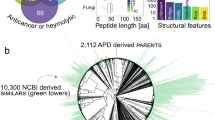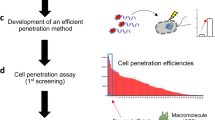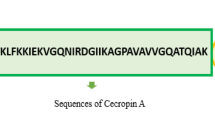Abstract
In biological systems, adenosine triphosphate (ATP) provides an energetic driving force for peptide bond formation, but protein chemists lack tools that emulate this strategy. Here we develop an ATP-driven platform for C-terminal activation and peptide ligation based on MccB, a bacterial ancestor of ubiquitin-activating (E1) enzymes. We show that MccB can act on non-native substrates to generate an O-AMPylated electrophile that reacts with exogenous nucleophiles to form diverse C-terminal functional groups including thioesters, a versatile class of biological intermediates that have been exploited for protein C-terminal bioconjugation. By mining the natural diversity of the MccB family, we identify both epitope-specific and more promiscuous MccBs. We show that epitope-specific MccB activity can be directed toward specific proteins of interest to enable high-yield, ATP-driven protein bioconjugation, and promiscuous MccB activity can be deployed for the synthesis of peptide thioester substrates for bioconjugation. Our method mimics the chemical logic of biological peptide bond synthesis for high-yield in vitro manipulation of protein structure with molecular precision.

This is a preview of subscription content, access via your institution
Access options
Access Nature and 54 other Nature Portfolio journals
Get Nature+, our best-value online-access subscription
$32.99 / 30 days
cancel any time
Subscribe to this journal
Receive 12 print issues and online access
$259.00 per year
only $21.58 per issue
Buy this article
- Purchase on SpringerLink
- Instant access to full article PDF
Prices may be subject to local taxes which are calculated during checkout






Similar content being viewed by others
Data availability
All data supporting the conclusions of this paper can be found in the main text, Supplementary Information or Dryad repository at https://doi.org/10.5061/dryad.c59zw3rkb (ref. 66). Source data are provided with this paper.
References
Gomez, M. A. R. & Ibba, M. Aminoacyl-tRNA synthetases. RNA 26, 910–936 (2020).
Cane, D. E., Walsh, C. T. & Khosla, C. Harnessing the biosynthetic code: combinations, permutations and mutations. Science 282, 63–68 (1998).
Schulman, B. A. & Harper, J. W. Ubiquitin-like protein activation by E1 enzymes: the apex for downstream signalling pathways. Nat. Rev. Mol. Cell Biol. 10, 319–331 (2009).
Walsh, C. T., Tu, B. P. & Tang, Y. Eight kinetically stable but thermodynamically activated molecules that power cell metabolism. Chem. Rev. 118, 1460–1494 (2018).
Westheimer, F. H. Why nature chose phosphates. Science 235, 1173–1178 (1987).
Thompson, R. E. & Muir, T. W. Chemoenzymatic semisynthesis of proteins. Chem. Rev. 120, 3051–3126 (2020).
Nguyen, G. K. T. et al. Butelase 1 is an Asx-specific ligase enabling peptide macrocyclization and synthesis. Nat. Chem. Biol. 10, 732–738 (2014).
Popp, M. W., Antos, J. M., Grotenbreg, G. M., Spooner, E. & Ploegh, H. L. Sortagging: a versatile method for protein labeling. Nat. Chem. Biol. 3, 707–708 (2007).
Popp, M. W. & Ploegh, H. L. Making and breaking peptide bonds: protein engineering using sortase. Angew. Chem. Int. Ed. 50, 5024–5032 (2011).
Fottner, M. et al. A modular toolbox to generate complex polymeric ubiquitin architectures using orthogonal sortase enzymes. Nat. Commun. 12, 6515 (2021).
Fottner, M. et al. Site-specific protein labeling and generation of defined ubiquitin-protein conjugates using an asparaginyl endopeptidase. J. Am. Chem. Soc. 144, 13118–13126 (2022).
Fottner, M. et al. Site-specific ubiquitylation and SUMOylation using genetic-code expansion and sortase. Nat. Chem. Biol. 15, 276–284 (2019).
Rehm, F. B. H. et al. Site-specific sequential protein labeling catalyzed by a single recombinant ligase. J. Am. Chem. Soc. 141, 17388–17393 (2019).
Abrahmsen, L. et al. Engineering subtilisin and its substrates for efficient ligation of peptide bonds in aqueous solution. Biochemistry 30, 4151–4159 (1991).
Nguyen, G. K. T., Cao, Y., Wang, W., Liu, C. F. & Tam, J. P. Site‐specific N‐terminal labeling of peptides and proteins using butelase 1 and thiodepsipeptide. Angew. Chem. 127, 15920–15924 (2015).
Williamson, D. J., Fascione, M. A., Webb, M. E. & Turnbull, W. B. Efficient N‐terminal labeling of proteins by use of sortase. Angew. Chem. 124, 9511–9514 (2012).
Pihl, R., Zheng, Q. & David, Y. Nature-inspired protein ligation and its applications. Nat. Rev. Chem. 7, 234–255 (2023).
Burroughs, A. M., Iyer, L. M. & Aravind, L. Natural history of the E1‐like superfamily: implication for adenylation, sulfur transfer, and ubiquitin conjugation. Proteins Struct. Funct. Bioinform. 75, 895–910 (2009).
Hochstrasser, M. All in the ubiquitin family. Science 289, 563–564 (2000).
Begley, T. P., Xi, J., Kinsland, C., Taylor, S. & McLafferty, F. The enzymology of sulfur activation during thiamin and biotin biosynthesis. Curr. Opin. Chem. Biol. 3, 623–629 (1999).
Rajagopalan, K. V. Biosynthesis and processing of the molybdenum cofactors. Biochem. Soc. Trans. 25, 757–761 (1997).
Roush, R. F., Nolan, E. M., Löhr, F. & Walsh, C. T. Maturation of an Escherichia coli ribosomal peptide antibiotic by ATP-consuming N-P bond formation in microcin C7. J. Am. Chem. Soc. 130, 3603–3609 (2008).
Regni, C. A. et al. How the MccB bacterial ancestor of ubiquitin E1 initiates biosynthesis of the microcin C7 antibiotic. EMBO J. 28, 1953–1964 (2009).
Dikic, I. & Schulman, B. A. An expanded lexicon for the ubiquitin code. Nat. Rev. Mol. Cell Biol. 24, 273–287 (2023).
Komander, D. & Rape, M. The ubiquitin code. Annu. Rev. Biochem. 81, 203–229 (2012).
Guijarro, J. I. et al. Chemical structure and translation inhibition studies of the antibiotic microcin C7. J. Biol. Chem. 270, 23520–23532 (1995).
Metlitskaya, A. et al. Maturation of the translation inhibitor microcin C. J. Bacteriol. 191, 2380–2387 (2009).
Kulikovsky, A. et al. The molecular mechanism of aminopropylation of peptide-nucleotide antibiotic microcin C. J. Am. Chem. Soc. 136, 11168–11175 (2014).
Novikova, M. et al. The Escherichia coli Yej transporter is required for the uptake of translation inhibitor microcin C. J. Bacteriol. 189, 8361–8365 (2007).
Metlitskaya, A. et al. Aspartyl-tRNA synthetase is the target of peptide nucleotide antibiotic microcin C. J. Biol. Chem. 281, 18033–18042 (2006).
Zukher, I. et al. Reiterative synthesis by the ribosome and recognition of the N-terminal formyl group by biosynthetic machinery contribute to evolutionary conservation of the length of antibiotic microcin C peptide precursor. mBio 10, e00768-19 (2019).
Bantysh, O. et al. Enzymatic synthesis of bioinformatically predicted microcin C-like compounds encoded by diverse bacteria. mBio 5, e01059-14 (2014).
Webb, M. R. A continuous spectrophotometric assay for inorganic phosphate and for measuring phosphate release kinetics in biological systems. Proc. Natl Acad. Sci. USA 89, 4884–4887 (1992).
Lloyd, A. J., Thomann, H.-U., Ibba, M. & Soöll, D. A broadly applicable continuous spectrophotometric assay for measuring aminoacyl-tRNA synthetase activity. Nucleic Acids Res. 23, 2886–2892 (1995).
Kazakov, T., Metlitskaya, A. & Severinov, K. Amino acid residues required for maturation, cell uptake and processing of translation inhibitor microcin C. J. Bacteriol. 189, 2114–2118 (2007).
Saha, A. & Deshaies, R. J. Multimodal activation of the ubiquitin ligase SCF by Nedd8 conjugation. Mol. Cell 32, 21–31 (2008).
Weeks, A. M. & Chang, M. C. Y. Catalytic control of enzymatic fluorine specificity. Proc. Natl Acad. Sci. USA 109, 19667–19672 (2012).
Matthews, M. L. et al. Chemoproteomic profiling and discovery of protein electrophiles in human cells. Nat. Chem. 9, 234–243 (2017).
Pickart, C. M. & Eddins, M. J. Ubiquitin: structures, functions, mechanisms. Biochim. Biophys. Acta Mol. Cell Res. 1695, 55–72 (2004).
Muir, T. W., Sondhi, D. & Cole, P. A. Expressed protein ligation: a general method for protein engineering. Proc. Natl Acad. Sci. USA 95, 6705–6710 (1998).
Fellouse, F. A. et al. High-throughput generation of synthetic antibodies from highly functional minimalist phage-displayed libraries. J. Mol. Biol. 373, 924–940 (2007).
Suzuki, T. et al. Development of cysteine-free fluorescent proteins for the oxidative environment. PLoS ONE 7, e37551 (2012).
Dorr, B. M., Ham, H. O., An, C., Chaikof, E. L. & Liu, D. R. Reprogramming the specificity of sortase enzymes. Proc. Natl Acad. Sci. USA 111, 13343–13348 (2014).
Podracky, C. J. et al. Laboratory evolution of a sortase enzyme that modifies amyloid-β protein. Nat. Chem. Biol. 17, 317–325 (2021).
Henager, S. H. et al. Enzyme-catalyzed expressed protein ligation. Nat. Methods 13, 925–927 (2016).
Weeks, A. M. & Wells, J. A. Subtiligase-catalyzed peptide ligation. Chem. Rev. 120, 3127–3160 (2019).
Henager, S. H., Henriquez, S., Dempsey, D. R. & Cole, P. A. Analysis of site-specific phosphorylation of PTEN by using enzyme-catalyzed expressed protein ligation. ChemBioChem 21, 64–68 (2020).
Chen, I., Dorr, B. M. & Liu, D. R. A general strategy for the evolution of bond-forming enzymes using yeast display. Proc. Natl Acad. Sci. USA 108, 11399–11404 (2011).
Hofmann, R., Akimoto, G., Wucherpfennig, T. G., Zeymer, C. & Bode, J. W. Lysine acylation using conjugating enzymes for site-specific modification and ubiquitination of recombinant proteins. Nat. Chem. 12, 1008–1015 (2020).
Muhar, M. F. et al. C-terminal amides mark proteins for degradation via SCF-FBXO31. Nature 638, 519–527 (2025).
Wang, M. & Casey, P. J. Protein prenylation: unique fats make their mark on biology. Nat. Rev. Mol. Cell Biol. 17, 110–122 (2016).
Clancy, K. W., Melvin, J. A. & McCafferty, D. G. Sortase transpeptidases: insights into mechanism, substrate specificity and inhibition. Pept. Sci. 94, 385–396 (2010).
Otto, H.-H. & Schirmeister, T. Cysteine proteases and their inhibitors. Chem. Rev. 97, 133–172 (1997).
Kane, P. M. et al. Protein splicing converts the yeast TFP1 gene product to the 69-kDa subunit of the vacuolar H+-adenosine triphosphatase. Science 250, 651–657 (1990).
Novikova, O. et al. Intein clustering suggests functional importance in different domains of life. Mol. Biol. Evol. 33, 783–799 (2016).
Berndsen, C. E. & Wolberger, C. New insights into ubiquitin E3 ligase mechanism. Nat. Struct. Mol. Biol. 21, 301–307 (2014).
Antos, J. M. et al. Site-specific N- and C-terminal labeling of a single polypeptide using sortases of different specificity. J. Am. Chem. Soc. 131, 10800–10801 (2009).
Hananya, N., Koren, S. & Muir, T. W. Interrogating epigenetic mechanisms with chemically customized chromatin. Nat. Rev. Genet. 25, 255–271 (2024).
Tarrant, M. K. et al. Regulation of CK2 by phosphorylation and O-GlcNAcylation revealed by semisynthesis. Nat. Chem. Biol. 8, 262–269 (2012).
Salguero, A. L. et al. Multifaceted regulation of Akt by diverse C-terminal post-translational modifications. ACS Chem. Biol. 17, 68–76 (2022).
Marotta, N. P. et al. O-GlcNAc modification blocks the aggregation and toxicity of the protein α-synuclein associated with Parkinson’s disease. Nat. Chem. 7, 913–920 (2015).
Levine, P. M. et al. α-Synuclein O-GlcNAcylation alters aggregation and toxicity, revealing certain residues as potential inhibitors of Parkinson’s disease. Proc. Natl Acad. Sci. USA 116, 1511–1519 (2019).
Balana, A. T. et al. O-GlcNAc forces an α-synuclein amyloid strain with notably diminished seeding and pathology. Nat. Chem. Biol. 20, 646–655 (2024).
Fernández-Suárez, M. et al. Redirecting lipoic acid ligase for cell surface protein labeling with small-molecule probes. Nat. Biotechnol. 25, 1483–1487 (2007).
Wu, P. et al. Site-specific chemical modification of recombinant proteins produced in mammalian cells by using the genetically encoded aldehyde tag. Proc. Natl Acad. Sci. USA 106, 3000–3005 (2009).
Frazier, C. L., Deb, D., Leiter, W. E., Mondal, U. & Weeks, A. M. Raw data and supplementary files for ‘Engineered reactivity of a bacterial E1-like enzyme enables ATP-driven modification of protein C termini’. Dryad https://doi.org/10.5061/dryad.c59zw3rkb (2025).
Hornsby, M. et al. A high through-put platform for recombinant antibodies to folded proteins. Mol. Cell. Proteom. 14, 2833–2847 (2015).
Zallot, R., Oberg, N. & Gerlt, J. A. The EFI Web Resource for genomic enzymology tools: leveraging protein, genome and metagenome databases to discover novel enzymes and metabolic pathways. Biochemistry 58, 4169–4182 (2019).
Oberg, N., Zallot, R. & Gerlt, J. A. EFI-EST, EFI-GNT and EFI-CGFP: Enzyme Function Initiative (EFI) Web Resource for genomic enzymology tools. J. Mol. Biol. 435, 168018 (2023).
Mistry, J. et al. Pfam: the protein families database in 2021. Nucleic Acids Res. 49, D412–D419 (2020).
UniProt Consortium. UniProt: the Universal Protein Knowledgebase in 2023. Nucleic Acids Res. 51, D523–D531 (2022).
Zheng, J.-S., Tang, S., Qi, Y.-K., Wang, Z.-P. & Liu, L. Chemical synthesis of proteins using peptide hydrazides as thioester surrogates. Nat. Protoc. 8, 2483–2495 (2013).
Acknowledgements
We thank S. Coyle, D. Sashital, T. Galateo, R. Rajasekaran, H. Bridge, L. Campbell, L. Mazurkiewicz, E. Johnson and members of the Weeks laboratory for helpful discussions. This work was supported in part by startup funds from the University of Wisconsin – Madison Department of Biochemistry and by an NIH Director’s New Innovator Award (DP2GM149548) to A.M.W. C.L.F. was supported in part by the University of Wisconsin – Madison Biotechnology Training Program under grant number NIH 5 T32 GM135066 and by a William H. Peterson Graduate Fellowship from the University of Wisconsin – Madison Department of Biochemistry. W.E.L. was supported in part by the National Institute of General Medical Sciences of the National Institutes of Health under award number T32 GM152341 (Chemistry–Biology Interface Training Program). The funders had no role in study design, data collection and analysis, decision to publish or preparation of the paper.
Author information
Authors and Affiliations
Contributions
C.L.F., D.D., W.E.L., U.M. and A.M.W. designed the experiments. C.L.F., D.D., W.E.L., U.M. and A.M.W. performed experiments. C.L.F., D.D., W.E.L., U.M. and A.M.W. analysed data. C.L.F., D.D. and A.M.W. wrote the paper. C.L.F., D.D., W.E.L., U.M. and A.M.W. reviewed and edited the paper.
Corresponding author
Ethics declarations
Competing interests
The Wisconsin Alumni Research Foundation has filed a provisional patent application related to this work on which C.L.F., D.D. and A.M.W. are inventors. The other authors declare no competing interests.
Peer review
Peer review information
Nature Chemistry thanks Kathrin Lang and the other, anonymous, reviewer(s) for their contribution to the peer review of this work.
Additional information
Publisher’s note Springer Nature remains neutral with regard to jurisdictional claims in published maps and institutional affiliations.
Extended data
Extended Data Fig. 1 MccB-generated thioesters undergo transthioesterification, S-to-N acyl transfer, and native chemical ligation.
(a) MccA-N7G thioester can undergo transthioesterification with MPAA, a thiol nucleophile that cannot directly capture Mcc-N7G-O-AMP. (b) MccA-N7G-O-AMP can undergo thioesterification and S-to-N acyl shift with Cys to form a peptide bond. (c) In the presence of ATP and Mesna, MccB catalyzes native chemical ligation between an unactivated peptide and an N-terminal Cys peptide.
Extended Data Fig. 2 MccB homologs from L. johnsonii and H. pylori can be used in combination with subtiligase for enzyme-catalysed expressed protein ligation.
(a) LjMccB- and subtiligase-catalysed ATP-dependent peptide ligation of Ala-Phe (left) or AFAGAGS-azAla (right) to GFP- LjTeCH. (b) HpMccB- and subtiligase-catalysed ATP-dependent peptide ligation of Ala-Phe (left) or AFAGAGS-azAla (right) to GFP-HpTeCH.
Extended Data Fig. 3 Comparison of MccB/subtiligase-catalysed and eSrtA-catalysed C-terminal protein modification.
(a) MccB/subtiligase-catalysed C-terminal peptide ligation to GS-GFP-TeCH. In the absence of peptide nucleophile, MccB and subtiligase catalyse GS-GFP cyclization, but this reaction is efficiently suppressed in the presence of 5 mM Ala-Phe. (b) eSrtA-catalysed C-terminal modification of GS-GFP-LPETGG. In the absence of nucleophile, eSrtA catalyzes GFP cyclization that cannot be completely suppressed even in the presence of 10 mM GGG peptide. (c) eSrtA cyclization is suppressed by removing the N-terminal GS sequence at the N terminus of GS-GFP-LPETGG.
Extended Data Fig. 4 Dual N- and C-terminal labeling of GS-MBP-TeCH using eSrtA and MccB/subtiligase.
(a) Scheme for dual N- and C-terminal label of GS-MBP-TeCH with MccB/subtiligase and eSrtA. The magenta circle represent azidoAla and the cyan circle represents 5-FAM. (b) Telescoping one-pot dual labeling of GS-MBP-TeCH with eSrtA and MccB/subtiligase. (c) Concurrent one-pot dual labeling of GS-MBP-TeCH with eSrtA and MccB/subtiligase.
Extended Data Fig. 5 Combining HsMccB-catalysed peptide thioester synthesis with Ubc9-catalysed lysine acylation.
(a) Scheme for lysine acylation using an HsMccB-generated thioester and GFP with an internal minimal LACE tag sequence (IKQE). (b) Scheme for lysine acylation using an HsMccB-generated thioester and GFP with a full length LACE tag sequence (PRKVIKMESEE). (c) Optimization of peptide thioester concentration in LACE reactions. (d) Optimization of thiol concentration at pH 7.6. Excess thiol suppresses the LACE reaction. (e) Optimization of thiol concentration at pH 8.0. Excess thiol suppresses the LACE reaction, which proceeds to higher yield at pH 8.0 compared to 7.6.
Supplementary information
Supplementary Information
Supplementary Tables 1–5 and Figs. 1–84.
Source data
Source Data Fig. 1
Unprocessed kinetics and conversion data for MccB-catalysed peptide reactions.
Source Data Fig. 2
Unprocessed extracted ion chromatograms and spectra for MccB-catalysed peptide reactions with nucleophile.
Source Data Fig. 3
Unprocessed deconvoluted mass spectra for MccB-catalysed thioesterification and modification of TeCH-tagged proteins.
Source Data Fig. 4
Heatmap intensity values and deconvoluted mass spectra for MccB homologue-catalysed protein modification.
Source Data Fig. 5
Unprocessed deconvoluted mass spectra for MccB application to enzyme-catalysed expressed protein ligation; unprocessed TIFF files from fluorescence microscopy experiments.
Source Data Fig. 6
Heatmap intensity values and unprocessed deconvoluted mass spectra for MccB application to the LACE system.
Rights and permissions
Springer Nature or its licensor (e.g. a society or other partner) holds exclusive rights to this article under a publishing agreement with the author(s) or other rightsholder(s); author self-archiving of the accepted manuscript version of this article is solely governed by the terms of such publishing agreement and applicable law.
About this article
Cite this article
Frazier, C.L., Deb, D., Leiter, W.E. et al. Engineered reactivity of a bacterial E1-like enzyme enables ATP-driven modification of protein and peptide C termini. Nat. Chem. 17, 1371–1382 (2025). https://doi.org/10.1038/s41557-025-01871-3
Received:
Accepted:
Published:
Issue date:
DOI: https://doi.org/10.1038/s41557-025-01871-3



